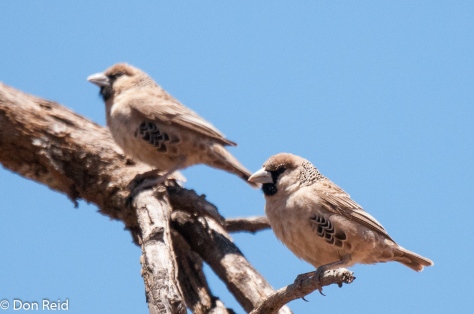The Sociable Weaver, chosen by Birdlife South Africa as their “Bird of the Year” for 2016, is unique in many respects and more than worthy of its selection.
It is also a bird that has fascinated me ever since I first saw their massive nest structures on Camelthorn trees in the Free State, long before my interest in birding began. This was in the early 1970’s when I moved to Bloemfontein, Free State and developed two loves – for my wife and for the wide open spaces of the Free State, represented by the family farm near Hoopstad.
Although the farm we used to visit every couple of weeks is no longer in the family, the same massive Sociable Weaver nest sits securely in the same Camelthorn tree in the family cemetery, watching over the generations of the family who have found their final resting place in its dappled shade.
Why Unique?
Apart from being endemic to Southern Africa, the Sociable Weaver’s nest is the largest built by any bird in the world, large enough to house more than a hundred pairs of birds, often of several generations (why am I thinking of the Dallas Ewings right now?). They construct these enormous nests of stiff grasses, forming chambers at different distances from the outside face, which provide protection from the temperature extremes of Southern Africa’s arid zones.
Described as being like “giant haystacks”, the nests are constructed in trees or on artificial structures such as telephone and electricity poles, windmills and the like and have become an icon of the arid areas of Southern Africa.


Species Names
Scientific : Philetairus socius – from the Greek philos = love and hetairos = companion
Afrikaans: Versamelvoël
Indigenous : Thantlagane(NS), Kgwêrêrê (Tw)
German : Siedelweber
French : Républicain social
Portuguese : Tecelão-sociável
Dutch : Republikeinwever

Distribution
Distribution is across north-western South Africa, south-west Botswana and northwards across Namibia and is strongly associated with the arid savannahs of the southern Kalahari region.
The SABAP2 distribution map looks like this :

Identification
The nest is unmistakable, so once you have found the nest the birds will not be far away. Although classed as Weavers they are more Sparrow-like in appearance, small (14cm) and fairly drab-coloured to match the dry browns of the habitat they prefer. Their outstanding features are the black chin contrasting with a light-coloured front and face, black barred flanks and scalloped back
Images
Other Stuff
Several other species “borrow” nest chambers for their own breeding – such as mud-nesting wasps, nesting Pygmy Falcons, Red-headed Finches and Rosy-faced Lovebirds. Others use them as roosts including Ashy Tits, Familiar Chats, Acacia Pied Barbets and Pearl-spotted Owlets. So the great nest becomes a “bird hotel” for many, even snakes like visiting for a nestling or egg take-away.
There is certainly nothing else quite like it in the bird world.
Additional sources :
Robert’s Multimedia Birds of Southern Africa
Latin for Birdwatchers (Roger Lederer and Carol Burr)
Wikipedia
Birdlife SA Media Release – Bird of the Year 2016







One thought on “Bird in the Lens – Sociable Weaver”